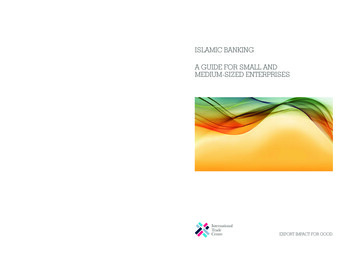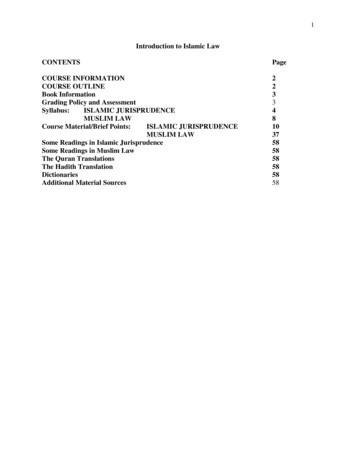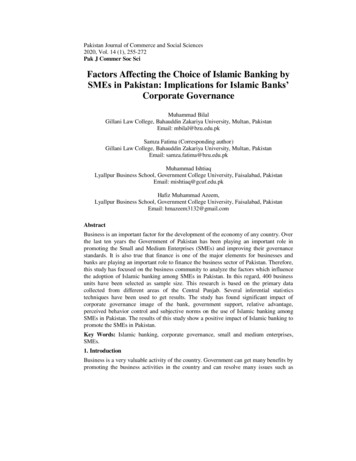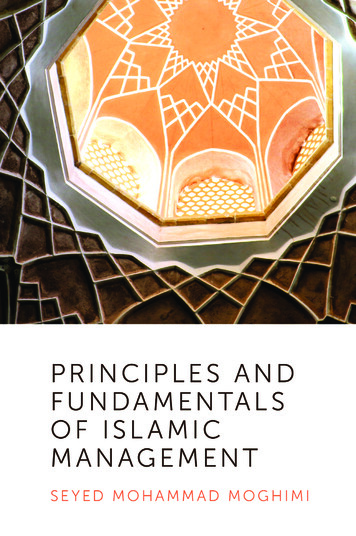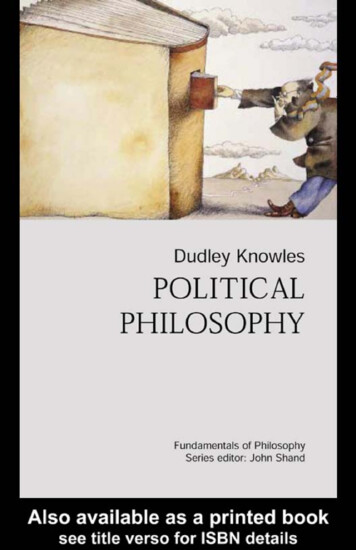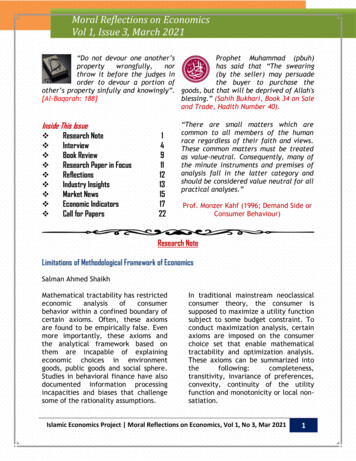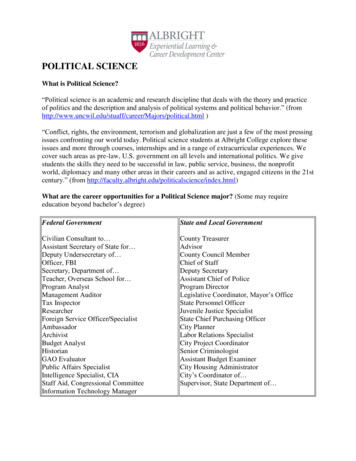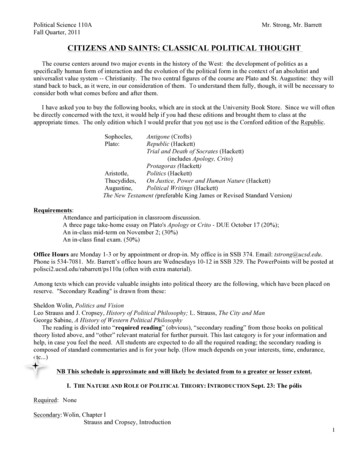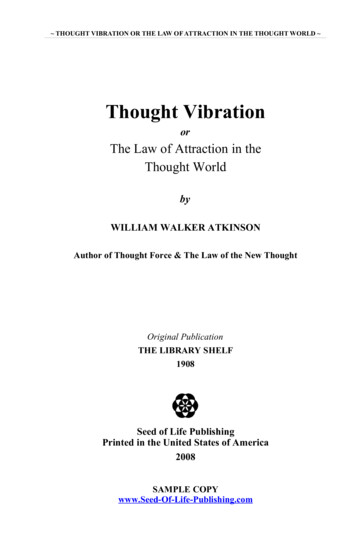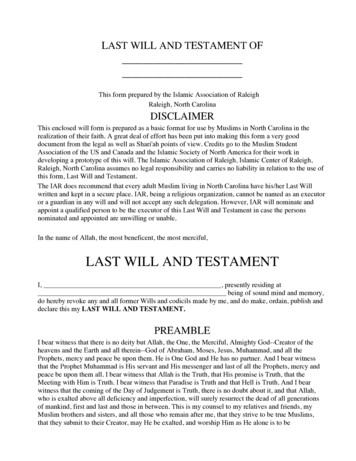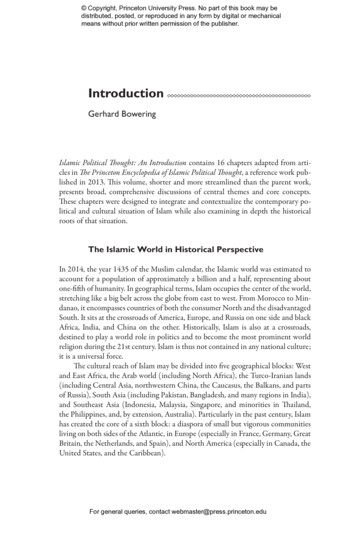
Transcription
Copyright, Princeton University Press. No part of this book may bedistributed, posted, or reproduced in any form by digital or mechanicalmeans without prior written permission of the publisher.IntroductionGerhard BoweringIslamic Political Thought: An Introduction contains 16 chapters adapted from articles in The Princeton Encyclopedia of Islamic Political Thought, a reference work published in 2013. This volume, shorter and more streamlined than the parent work,presents broad, comprehensive discussions of central themes and core concepts.These chapters were designed to integrate and contextualize the contemporary political and cultural situation of Islam while also examining in depth the historicalroots of that situation.The Islamic World in Historical PerspectiveIn 2014, the year 1435 of the Muslim calendar, the Islamic world was estimated toaccount for a population of approximately a billion and a half, representing aboutone- fifth of humanity. In geographical terms, Islam occupies the center of the world,stretching like a big belt across the globe from east to west. From Morocco to Min danao, it encompasses countries of both the consumer North and the disadvantagedSouth. It sits at the crossroads of America, Europe, and Russia on one side and blackAfrica, India, and China on the other. Historically, Islam is also at a crossroads,destined to play a world role in politics and to become the most prominent worldreligion during the 21st century. Islam is thus not contained in any national culture;it is a universal force.The cultural reach of Islam may be divided into five geographical blocks: Westand East Africa, the Arab world (including North Africa), the Turco- Iranian lands(including Central Asia, northwestern China, the Caucasus, the Balkans, and partsof Russia), South Asia (including Pakistan, Bangladesh, and many regions in India),and Southeast Asia (Indonesia, Malaysia, Singapore, and minorities in Thailand,the Philippines, and, by extension, Australia). Particularly in the past century, Islamhas created the core of a sixth block: a diaspora of small but vigorous communitiesliving on both sides of the Atlantic, in Europe (especially in France, Germany, GreatBritain, the Netherlands, and Spain), and North America (especially in Canada, theUnited States, and the Caribbean).For general queries, contact webmaster@press.princeton.edu
Copyright, Princeton University Press. No part of this book may bedistributed, posted, or reproduced in any form by digital or mechanicalmeans without prior written permission of the publisher.2 IntroductionIslam has grown consistently throughout history, expanding into new neighboring territories without ever retreating (except on the margins, as in Sicily and Spain,where it was expelled by force). It began in the seventh century as a small communityin Mecca and Medina in the Arabian Peninsula, led by its messenger the ProphetMuhammad (d. 632), who was eventually to unite all the Arab tribes under the banner of Islam. Within the first two centuries of its existence, Islam came into globalprominence through its conquests of the Middle East, North Africa, the IberianPeninsula, the Iranian lands, Central Asia, and the Indus valley. In the process andaftermath of these conquests, Islam inherited the legacy of the ancient Egyptian andMesopotamian civilizations, embraced and transformed the heritage of Hellenisticphilosophy and science, assimilated the subtleties of Persian statecraft, incorporatedthe reasoning of Jewish law and the methods of Christian theology, absorbed culturalpatterns of Zoroastrian dualism and Manichean speculation, and acquired wisdomfrom Mahayana Buddhism and Indian philosophy and science. Its great cosmopolitan centers— Baghdad, Cairo, Córdoba, Damascus, and Samarqand— became thefurnace in which the energy of these cultural traditions was converted into a newreligion and polity. These major cities, as well as provincial capitals of the newlyfounded Islamic empire, such as Basra, Kufa, Aleppo, Qayrawan, Fez, Rayy (Tehran),Nishapur, and Sanaa merged the legacy of the Arab tribal tradition with newly incorporated cultural trends. By religious conversion, whether fervent, formal, or forced,Islam integrated heterodox and orthodox Christians of Greek, Syriac, and Latin rites,and included large numbers of Jews, Zoroastrians, Gnostics, and Manicheans. Byethnic assimilation, it absorbed a great variety of nations, whether through compacts, clientage and marriage, persuasion, threat, or through religious indifference,social climbing, and self- interest of newly conquered peoples. It embraced Aramaic- ,Persian- , and Berber- speaking peoples, accommodated the disruptive incursions ofTurks and the devastating invasion of Mongols into its territories, and sent out itsemissaries, traders, immigrants, and colonists into the lands beyond the Indus valley, the semiarid plains south of the Sahara, and the distant shores of the SoutheastAsian islands.By transforming the world during the ascendancy of the Abbasid Empire(750– 1258), Islam created a splendid cosmopolitan civilization built on the Arabic language; the message of its scripture, tradition, and law (Qur’an, hadith, andshari‘a); and the wisdom and science of the cultures newly incorporated during itsexpansion over three continents. The practice of philosophy, medicine, and the sciences within the Islamic empire was at a level of sophistication unmatched by anyother civilization; it secured pride of place in such diverse fields as architecture,philosophy, maritime navigation and trade, and commerce by land and sea, andsaw the founding of the world’s first universities. Recuperating from two centuriesof relative political decentralization, it coalesced about the year 1500 in three greatempires, the Ottomans in the West with Istanbul as their center, the Safavids in Iranwith Isfahan as their hub, and the Mughals in the Indian subcontinent with Agraand Delhi as their axis.For general queries, contact webmaster@press.princeton.edu
Copyright, Princeton University Press. No part of this book may bedistributed, posted, or reproduced in any form by digital or mechanicalmeans without prior written permission of the publisher.Introduction 3As the Islamic world witnessed the emergence of these three empires, Europeanpowers began to expand their influence over the world during the age of global discoveries, westward across the Atlantic into the Americas, and eastward by chartinga navigational route around Africa into the Indian Ocean, there entering into fiercecompetition with regional powers along the long- established network of traderoutes between China on the one hand and the Mediterranean and East Africa onthe other. The European exploration of the East and the growing ability to exploitan existing vast trade network, together with the inadvertent but eventually lucrative “discovery” of the New World, were to result in Europe’s economic and politicalhegemony over the Islamic world, with which it had rubbed military and mercantileshoulders since the early Muslim conquests. The early modern Islamic world (andmuch of the rest of the world) fell definitively behind the West economically andpolitically with the advent of the Enlightenment in the 18th century and the Industrial Revolution in the 19th century.By about 1800, small European nations (e.g., England, France, and Holland)had established rule over large regions of the Islamic world. Their trading companies and imperial outposts in distant Muslim lands were transformed into coloniesof European supremacy that were eager to benefit from Western industrialization.It took until the end of World War II for the global geopolitical map to becomereorganized into an array of discrete nation- states on the European model. Muslimnations perceived Islam not only as the way of life led by the majority of the population but also as the source of normative principles for social order.In the 19th century two diametrically opposed trends would preoccupy theMuslim intelligentsia in their effort to effect social and religious renewal. Modernism proposed adapting Islam to Western ideals, while revivalism advocated restoringthe vigor of the original dynamics of Islam; neither approach would lead to theutopia of a Pan- Islamic caliphate. Islam was now challenged to express itself withinthe framework of independent nations, with their focus on ethnicity, territoriality,and culture.At the beginning of the 20th century, the Islamic world witnessed the explosion of Turkish secularism; in its middle period, it sought sovereignty and honorin Arab, Iranian, Pakistani, and Indonesian nationalism; at the end of the 20thcentury, it became increasingly dominated by militant trends. “Islamism,” a fundamentalist reaction to Western ascendancy, calls for an Islamic state rigorously basedon Islamic law; its public image is dominated by marginal yet high- profile extremists advocating the use of terrorist attacks and suicide martyr missions to achievethis end. Both Sunni and Shi‘i expressions of Islamism— in Algeria, Sudan, Iran, orAfghanistan— were inspired by their belief that if only Muslims were to return totheir religious roots, God would grant them success in this world and bliss in thenext. The past glory of the Islamic world would be restored, and the West wouldagain study at its feet.At the beginning of the 21st century, the world has drawn closer togetherthrough the power of advanced technology, the speed of global communication,For general queries, contact webmaster@press.princeton.edu
Copyright, Princeton University Press. No part of this book may bedistributed, posted, or reproduced in any form by digital or mechanicalmeans without prior written permission of the publisher.4 Introductionand ubiquitous access to mobile phones and the Internet, including social networking services. Those advances enabled the annihilation of the Twin Towers in NewYork City on September 11, 2001, and other acts of terror that have occurred sincethat date. Yet they also may be nurturing a different response of Islam to the modernworld, as rumblings of freedom, cries for liberation from corrupt regimes, and callsfor democratic forms of government echo from Muslim lands through cyberspace.The Evolution of Islamic Political ThoughtThe development of Islamic political thought tracks the differing positions Islamhas occupied during its political expansion over the course of 14 centuries. Just asIslamic history both preserved its tradition and reshaped its internal culture consistently over this period of expansion, so did Islamic political thought maintaincertain principal foundations while undergoing successive stages of evolution. Thefoundations of Islam neither allow for distinctions between spiritual and temporal,ecclesiastical and civil, or religious and secular categories, nor envisage the sameduality of authority accepted in Western political thought as standard, such asGod and Caesar, church and state, and clergy and laity. Over the centuries, Islamicforms of state and government, power and authority, and rule and loyalty haveexhibited great diversity. Although they were all based on the premise of a unityof religion and state, it has nonetheless been impossible for Islam to formulate anorm of political thought that would stand above and apart from its various cultural permutations.In contrast to the West, the respective realms of religion and state are intimatelyintertwined in Islam and subject to a process of fluid negotiation; the concepts ofauthority and duty overshadow those of freedom and the rights of the individual.Islamic political thought deals not only with matters of government, politics, andthe state, but also addresses questions of acceptable behavior and ethics of boththe ruler and the ruled before God. Islamic political thought cannot be measuredby Western criteria and standards of political theory. It must be understood fromwithin its own tradition, characterized by a vibrant integration of the secular andsacred in obedience to God and His Prophet. In its very nature, Islam is dynamic,not static, both as a way of life and a way of monotheistic worship. It is a living reality rather than a frozen system.Rudimentary but enduring foundations for Islamic political thought werelaid beginning with the Prophet’s career in Medina. Significant divisions, however,came to the fore under the Umayyad caliphs (658– 750), the first Arab dynastyruling from Damascus. Arabic, the language of Muhammad and his early successors (632– 61), was propagated by the conquests of Islam and became establishedas the language of high Islamic culture and political thought during the caliphate of‘Abd al- Malik (685– 705). On the criterion of its scripture (kitāb), Islamic politicalthought enforced the basic principle of obedience to God and His Prophet. ThatFor general queries, contact webmaster@press.princeton.edu
Copyright, Princeton University Press. No part of this book may bedistributed, posted, or reproduced in any form by digital or mechanicalmeans without prior written permission of the publisher.Introduction 5principle was articulated in the nucleus of its creed, the shahāda, and extrapolatedin oral tradition by the early practice of the community, modeled after the Prophet,known as its sunna.The Umayyad rulers belonging to the Quraysh, Muhammad’s tribe, claimed tobe the rightful caliphs as heirs to the Prophet but saw their leadership challenged byboth the Shi‘is, who reserved legitimate leadership for Muhammad’s family, and theKharijis, who advocated that the most meritorious Muslim be the ideal caliph. Bythe end of the Umayyad caliphate in 750, the stage had been set for Islamic politicalthought to evolve through five successive periods, the trajectory of which may besummarized as follows.750– 1055: The early medieval formulations of Islamic political thought duringthe ascendancy of the Abbasid caliphate at Baghdad developed in three directions:those of the clerical class of administrators (kuttāb), the schools of legal scholars(‘ulama’, fuqahā’) and theologians (mutakallimūn), and the circles of philosophers(falāsifa). Over a period of five centuries, Islamic thinkers integrated the thoughtpatterns of a great variety of peoples, absorbing the intellectual systems brought intoits fold by the converted populations of the Iranian empire and the Byzantine provinces. It appropriated the legacy of their learning and the acumen of their politicalexperience with the help of comprehensive translation movements from Greek andPahlavi into Arabic.1055– 1258: During this stage, Islamic political thought had to address theupheaval caused by Sunni Turkic nomads from Central Asia. Turkic sultans gainedeffective military control and cut into the economic and administrative strata of anIran- based society nominally ruled by the Abbasid caliphs. The Turkic Seljuqs neither intended nor attempted to impose their language, culture, and seminomadicsocial order on the fabric of the Islamic polity; instead they wholeheartedly adoptedIslam as their religion and promoted Persian next to Arabic as a language of higherlearning.1258– 1500: After the demise of the attenuated Abbasid caliphate of Baghdad in 1258 during the Mongol invasions, Muslim political thinkers were forced tocome to terms with three new political powers in the east: (1) Ilkhanid and thenTimurid rule in Iran and Iraq; (2) khanate rule of the Golden Horde from Siberiato the Caucasus and from the Urals to the Danube River; and (3) Delhi- based sultanates in India. Farther to the west it saw military control passed into the handsof Mamluk Turks and Circassians who, uprooted from their homelands as militaryslaves, were sold into the households of their patrons and emancipated as convertsto Islam to serve as soldiers in the Mamluk armies in Egypt and Syria. Control ofthe polity was thus usurped by a medley of foreign khanates and slave sultanates,each attempting to claim legitimacy through the manipulation of Islamic symbolsof just rule and institutional affiliation with Sufi shaykhs. Faced with this fragmentation, Islamic political thinkers sought to find new paradigms that reflected theeffort to overcome the tumultuous breakdown of order and managed to integratethe foreign conquerors into their community’s religion and polity.For general queries, contact webmaster@press.princeton.edu
Copyright, Princeton University Press. No part of this book may bedistributed, posted, or reproduced in any form by digital or mechanicalmeans without prior written permission of the publisher.6 Introduction1500– 1800: From about 1500 onward, the division of the Islamic world intosultanates was succeeded by the rise of three separate and flourishing monarchicempires, none of which used Arabic as their official language of discourse and administration. The Turkish- speaking Ottomans, who had conquered Constantinoplein 1453 (now named Istanbul as their seat of government), added Syria and Egyptto their empire in 1517 and eventually adopted the title and legacy of Sunni caliphs.Adopting the Persian idiom, the Safavids established themselves in Iran in 1501 andtransformed it into a theocratic Imami Shi‘i monarchy. The Mughals, developinga Persian- speaking culture, established their predominantly Sunni rule over Indiawith their victory at Panipat in 1526. In this new threefold constellation, politicaltheory was made to serve the particular vision of rule of each empire rather thanthat of a universal caliphal culture, and thus Islamic political thought was shapedaccording to three different modes.From 1800 onward: The multifarious search for rationales of Islamic politicalthought from 1800 onward struggled with a situation the world of Islam had neverencountered before in its history. It was challenged by a Western culture that hadentered its ascendancy. For the first time, Islam neither had the power to conquernor the capacity to absorb the opposing culture. In response to this anxious andoften desperate situation, there gradually emerged revival movements and nationalisms in the Islamic world, whose ideologies covered the spectrum from puritanism, reformism, modernism, secularism, nationalism, and socialism to the extremesof fundamentalism, often termed Islamism. Its apogees are represented on the onehand by the Iranian Revolution of 1979 and on the other hand by the terrorist attack of September 11, 2001, against the United States.Foundations of Islamic Political Thought(from Muhammad to 750)Both Islamic history and Islamic political thought began in the twilight of LateAntiquity with the hijra, the emigration of the Prophet from Mecca to Medina in622. During his prophetic career in Mecca, Muhammad preached with the expectation of apocalyptic end times, focusing his listeners on their future in the hereafterand reminding them of their individual accountability before God. In Medina, hechanged course, dominated by the urge to establish the collective religious unityof a community that would enter history here and now, and shape a polity in thisworld. Once the proclamation of the Qur’an came to an end with the death of theProphet, eschatological concerns faded; Muslims focused on the victories of theArab conquest and the resulting exigencies of empire- building and the shaping ofpolity. The caliphs took charge in their succession to the Prophet as leaders of thecommunity. The crisis (fitna) of fraternal wars of succession within the ranks of thebelievers pitted insiders against outsiders, early Arab Muslims against new clientconverts, orthodox against heterodox, tribes against tribes, regions against regions,For general queries, contact webmaster@press.princeton.edu
Copyright, Princeton University Press. No part of this book may bedistributed, posted, or reproduced in any form by digital or mechanicalmeans without prior written permission of the publisher.Introduction 7and dynasties against dynasties. It gave rise to sects and parties but, ultimately, didnot dismantle the body politic, even though, from the ninth century onward, itallowed for the separation of political functions between caliphs, military amirs,and viziers administering the state. Neither the bifurcation of the caliphate in themiddle of the tenth century into the Muslim East under the Buyid amirs in Baghdad and the Muslim West of the Fatimid caliphs in Cairo (and the Umayyad caliphsin Córdoba) nor the influx of Turks and Mongols, respectively, in the middle of the11th and 13th centuries destroyed the cohesive but highly flexible structure of theIslamic polity.Early medieval Islamic political thought proved masterfully able to build onthe rudimentary foundations of the earliest phase of Islam. Although the Qur’anwas not designed to be a book of political thought, it included language that Muslim political thinkers adopted in their formulation of essential concepts. In addition, Muhammad’s organization of Medinan society, through a document knownas the Constitution of Medina, offered a model of applied political thought and aglimpse into the Prophet’s pragmatic approach toward the creation of a new polity.The first four caliphs conquered and quickly established themselves as administrators of the core lands of the future empire and encapsulated their political vision inshort directives and instructions. In Umayyad times, the caliphs defended Musliminterests, regarding the state as their family’s benefice. The people, most of whomwere non- Muslim, were regarded as clients under the caliph’s patronage, providingthe tax revenue needed by the state. As deputy (khalīfa) of the Prophet, the ruleroversaw the rule of law and demanded unconditional obedience on the part of hissubjects. Differing views about government and society were put down decisivelyas manifested by the neutralization of the Shi‘is and the suppression of the Kharijis.Islamic Political Thought in the EarlyMiddle Ages (750– 1055)Upon the accession of the Abbasids as rulers of the empire in 750, the caliph actedas the protector of religion and state (dīn wa- dawla). His government was God’sshadow on Earth, under whose sheltering protection everyone could find refuge.The clerical class (kuttāb) undertook impressive Arabic translations of Persian treatises on Iranian political institutions, a movement spearheaded by its principal proponent, Ibn al- Muqaffa‘ (d. 756), the champion of the courtly ideal of government(adab). The Book of the Land- tax, written by the chief judge Abu Yusuf (d. 798) atthe behest of caliph Harun al- Rashid, set a precedent for treatises on governmentand fiscal matters written by ‘ulama’. In it he covered not only the rules of taxationbut also legal and ethical principles as applied to social groups. He defined the roleof the caliph as the shepherd of his flock and stressed his obligation to establishdivine order among the small and the great. The caliph Ma’mun’s (r. 813– 33) attempt to establish a high imperial ideal with the primacy of the caliph over theFor general queries, contact webmaster@press.princeton.edu
Copyright, Princeton University Press. No part of this book may bedistributed, posted, or reproduced in any form by digital or mechanicalmeans without prior written permission of the publisher.8 Introductionclerical class and the learned elite produced a flourishing high culture infused withthe Hellenistic heritage. Neoplatonism, in particular, entered into Islamic politicalthought through a translation movement of Greek (via Syriac) into Arabic. Afterthe failure of the mih na (trial), the inquisition enforced by an edict of the caliphto impose the theological doctrines of the Mu‘tazilis as state creed, however, theclerical and learned classes found a way to resist caliphal authority in matters ofreligious doctrine and law.The seat of the caliphs in the center of the circular capital city of Baghdad,conceived as an ideal city, did not become a throne for a pope- like authority; rather,the caliphate had to acknowledge that the ‘ulama’, inspired by Shafi‘i (d. 820) andIbn Hanbal (d. 855), held the allegiance of the masses and would exclusively andcollectively represent the teaching authority in Sunni Islam on a consensual basis.The situation was very different with the Shi‘is, who emphasized the teaching authority of their ideal leader. They advocated a theory in which overriding authoritywas vested in the infallible imam, the gate (bāb) through whom God is approachedand the guarantee (h ujja) without whom the world would collapse. The Shi‘is, a minority weakened by internal dissensions and schisms, were unable to establish theirown political theology as normative and readied themselves to endure the injusticeof Sunni ruling institutions by embracing the principle of cautious dissimulation(taqiyya). They were sustained by their belief in the hidden presence of the imamand their projection into the future of the Mahdi’s apocalyptic return.The articulate political thought developed by the Muslim philosophers arguedfor a political society (madīna) that evoked the Greek ideal city (polis), whence derived the name of madīnat al- salām (City of Peace) that the Abbasids adopted forBaghdad, their capital. Farabi (870– 950) and Ibn Sina (980– 1037), both hailingfrom Transoxiana, focused on the center of the empire and supported the ideal ofthe philosopher- king, an ethically perfect individual, as head of a virtuous polity.Farabi’s ideal of “the virtuous city” (al- madīna al- fād ila) offered a systematic thesison the state as the perfect society, in which rational integrity and right conduct arethe means for achieving supreme felicity (sa‘āda). Just as the human body has different parts doing different work in a harmonious manner, so too does the body politicrequire an efficient division of labor. Just as the body has a head to rule it, so toosociety has a chief to rule it, guiding society toward becoming an ideal communityof the virtuous. Ibn Sina’s chapter on governance (siyāsa) in his encyclopedic work,The Healing of the Soul (al- Shifa’ ), stressed the principle of human interdependenceand promoted the ideal of the lawgiver who is both philosopher and prophet. Responding to the need for human government in a religious polity and remindingbelievers of God and the afterlife, the ruler guarantees the observance of the civil(nāmūs) and religious (shari‘a) law.Anchored in reason (‘aql ) as its ultimate principle and worked out acrossboundaries of religious affiliations between Muslims and Christians, the politicaltheory of the Islamic philosophers charted an intellectual trajectory that the majority of the Sunni population was unprepared or unwilling to follow. Unlike theFor general queries, contact webmaster@press.princeton.edu
Copyright, Princeton University Press. No part of this book may bedistributed, posted, or reproduced in any form by digital or mechanicalmeans without prior written permission of the publisher.Introduction 9philosophical elite, the Sunni masses needed a political thought system establishedon the platform of tradition, not abstract reason. Islamic philosophy lacked theinstitutional basis that an academy would have provided and did not manage toattract the popularly important scholars of law and religion with their deep rootsin the literature of the traditions of the Prophet and his Companions (hadith) andtheir codices of jurisprudence detailing the stipulations of shari‘a and amassing amyriad of opinions on legal points (fatwa).Islamic Political Thought in the HighMiddle Ages (1055– 1258)The political vision of Sunni Islam can be traced in two classical works on public law: the Arabic treatise on The Principles of Power (al- Ahkam al- Sultaniyya)by Mawardi (974– 1058), the honorary chief judge of the Abbasid caliphs, whodefined the standard theory of the Sunni caliphate and its institutions from theperspective of the ‘ulama’; and the Siyasatnama, the famous Persian work on statecraft by Nizam al- Mulk (1018– 92), chief vizier of the Seljuqs, that gives expressionto the views of the clerical class. Nizam al- Mulk also created the foundations ofa network of educational institutions (madrasas) that offered scholars of law andreligion lecterns and listeners for the dissemination of their works for many centuries. The Siyasatnama, together with the Qabusnama, written in 1082 by Kay Ka’us,represents the apogee of the literary genre of nas īh at al- mulūk (Advice for Rulers),that is, Mirrors for Princes literature that counseled political leaders on statecraftand diplomacy. Thriving for more than a millennium, the genre continued withtreatises of Sufis and courtiers on ethical conduct in political life, and reached itsfinal flourishing during the Mughal and Ottoman empires.The impact of medieval Islamic political thought is best exemplified by the classical work of Ghazali (1058– 1111), presented with great didactic clarity in his encyclopedic Revival of the Religious Sciences (Ihya’ ‘Ulum al- Din), which relied on thelegal tradition of the Shafi‘i school of law and the theological tradition of Baqillani(d. 1013) and Juwayni (1028– 85). The major achievement of Ghazali’s magisterialwork, however, was the theological and ethical platform he laid for Islamic politicalinstitutions, a platform that enabled the moral and religious renewal of Islamic society. Offering a Sunni theological interpretation of political thought, Fakhr al- Dinal- Razi (1149– 1209) tried to combine dialectical theology with a modified versionof Ibn Sina’s philosophy in order to support the doctrine that the existence of theking- emperor, namely, the caliph, is necessary to maintain the order of the world.On the far western periphery of the Islamic world in the Iberian Peninsula,Ghazali’s books were burned in public by order of the ruling dynasty, bowing tothe agitation of Maliki legal scholars. Significant contributions to Isla
Introduction Gerhard Bowering Islamic Political Thought: An Introduction contains 16 chapters adapted from arti- cles in The Princeton Encyclopedia of Islamic Political Thought, a reference work pub- lished in 2013. This v
